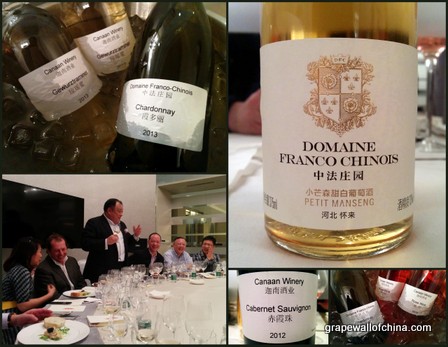
I first visited Domaine Franco-Chinois in 2008 with the writer Lawrence Osborne, so long ago he has since published the books Ballad of a Small Player, The Forgiven and The Wet & The Dry: A Drinker’s Journey. Osborne had come from New York to write a magazine story about the local drinking scene. We met at the Hilton for the dreary mid-January ninety-minute drive to DFC, then known by the name Sino-French Demonstration Vineyard, a nod to its beginnings as a joint scientific venture aimed at discovering what vines work best in that part of Hebei Province.
There is little doubt Osborne had low expectations. They likely dropped a few more notches as we arrived to a barren landscape: the vines at DFC had been buried to protect them from the dry cold winter. Such a situation doesn’t inspire thoughts of great wine.
Those sleeping vines represented over a dozen grape varieties as well as the potential for wine in Hebei. They were planted around the year 2000, under the project’s supervisor, Nicolas Billot-Grima, who first made wine in China in the late 1980’s. On our visit, we met Li Demei, who joined the project a few years after the initial talks and would soon help put Ningxia winery Helan Qing Xue on the map.
In any case, Li led us through 14 wines. They included a few beyond the typical Cabernets, such as Marsellan and Viognier-Riesling, although none were yet on the market. Several impressed Osborne but the best came last: a late-harvest Petit Manseng. In fact, when I was best man at a Beijing wedding a few years later, I sourced several bottles of this from DRC to serve at the head table.
What’s the point of this long introduction? That DRC showed an ability to make intriguing wines as far back as eight years ago. Not only that, it became a private venture about five years ago and thus made possible sales to the consumer market. Yet, and here is the bad news, after all these years — and Osborne books — we still can’t buy these wines.
Now some good news. I recently attended a tasting hosted by DFC GMÂ Tom Hsu. It included wines from DFC and newer project Canaan — not to be confused with Kanaan in Ningxia — a kilometer away. Word is some of these wines will be available this year.
Winemaker Zhao Desheng, who joined DFC in 2003 after spending two year in Bordeaux, effused about Canaan during the tasting. He said the project has three levels: one at 500 meters with red varieties like Cabernet Sauvignon, Merlot, Syrah, Petit Verdot and Tempanillo; one at 600 meters with Pinot Noir and early ripening reds; and one at 900 meters with whites like Gewurtztraminer and Sauvignon Blanc as well as more Pinot Noir.
“Not only the climate but also the soil of those three vineyards are very different,” says Zhao.
The first vines were planted in 2009. There are now 200 hectares of them with plans to eventually raise that to 600 or 700 hectares. All of the vines are on rootstock, he says.
We tried a dozen wines during the tasting.
Canaan Cabernet Sauvignon 2012 is a garnet color and has youthful plum aromas with spicy, oak-y and meaty elements. This wine is fresh and soft, with some spiciness.
The 2011 is even darker and is more complex, with dark berry, cocoa and spicy aromas. This is fruitier than the 2012 and has nice tannins, with a touch of green at the finish.
DFC Reserve Bordeaux Blend 2012 is purplish-red. This one has dark ripe berry aromas, plus chocolate and twig. (It seemed a bit oak-y to me.)
The Marselan 2011 was a dark garnet and fairly aromatic, if dusty. I picked up cherry and chocolate, some underlying funky and meaty smells, and later, after the wine breathed, fresh red berries. This wine was juicy, relatively rich, and had “chewy” tannins. Maybe it was partly the novelty of drinking Marselan, but I liked this one.
The same goes for the two late-harvest Petit Manseng we tried. The 2009 is a copper color, with aromas of honey, apricot and sweet dry grass, the aroma bordering on marijuana. This wine is sweet but not cloying. The 2011 is medium gold, with mild honey, citrus, light grass and dry toast aromas, and is drier than the 2009.
Anyway, that is just my take on some of the wines. I have enjoyed wine from DFC over the years — and now from Canaan, especially the Cabernet Sauvignon — and hope they find their way to market. These wines have the potential to not only help do what Grace did for Shanxi and Silver Heights did for Ningxia but also underscore the potential for wine in China beyond Cabernet blends.
Sign up for the Grape Wall newsletter here. Follow Grape Wall on LinkedIn, Instagram, Facebook and Twitter. And see my sibling sites World Marselan Day, World Baijiu Day and Beijing Boyce. Grape Wall has no advertisers, so if you find the content useful, please help cover the costs via PayPal, WeChat or Alipay. Contact Grape Wall via grapewallofchina (at) gmail.com.
Leave a Reply
You must be logged in to post a comment.